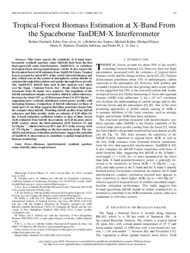Tropical-Forest Biomass Estimation at X-Band From the Spaceborne TanDEM-X Interferometer.
Tropical-Forest Biomass Estimation at X-Band From the Spaceborne TanDEM-X Interferometer.
Author(s): TREUHAFT, R.; GONÇALVES, F.; SANTOS, J. R. DOS; KELLER, M.; PALACE, M.; MADSEN, S. N.; SULLIVAN, F.; GRAÇA, P. M. L. A.
Summary: This letter reports the sensitivity of X-band interferometric synthetic aperture radar (InSAR) data from the first dual-spacecraft radar interferometer, TanDEM-X, to variations in tropical-forest aboveground biomass (AGB). It also reports the first tropical-forest AGB estimates fromTanDEM-X data. Tropical forests account for about 50% of the world?s forested biomass and play critical roles in the control of atmospheric carbon dioxide by emission through deforestation and uptake through forest growth.The TanDEM-X InSAR data used in this analysis were taken over the Tapajós National Forest, Pará, Brazil, where field measurements from 30 stands were acquired. The magnitude of the InSAR normalized complex correlation, which is called coherence, decreases by about 25% as AGB increases from 2 to 430 Mg-ha−1, suggesting more vertically distributed return-power profiles with increasing biomass. Comparison of InSAR coherences to those of small-spot (15 cm) lidar suggests that lidar penetrates deeper into the canopies than InSAR. Modeling InSAR profiles from InSAR coherence and lidar profiles yields an estimate of 0.29 dB/m for the X-band extinction coefficient relative to that of lidar. Forest AGB estimated from InSAR observations on 0.25-ha plots shows RMS scatters about the field-estimated AGB between 52 and 62 Mg-ha−1, which is between 29% and 35% of the average AGB of 179 Mg-ha−1, depending on the data analysis mode. The sensitivity and biomass-estimation performance suggest the potential of TanDEM-X observations to contribute to global tropical-forest biomass monitoring.
Publication year: 2014
Types of publication: Journal article
Unit: Embrapa Territorial
Observation
Some of Embrapa's publications are published as ePub files. To read them, use or download one of the following free software options to your computer or mobile device. Android: Google Play Books; IOS: iBooks; Windows and Linux: Calibre.
Access other publications
Access the Agricultural Research Database (BDPA) to consult Embrapa's full library collection and records.
Visit Embrapa Bookstore to purchase books and other publications sold by Embrapa.

